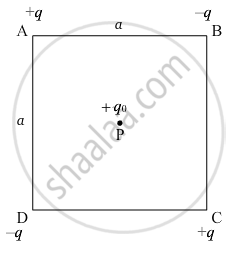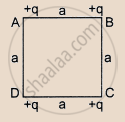Advertisements
Advertisements
प्रश्न
Four charges +q, −q, +q and −q are to be arranged respectively at the four corners of a square ABCD of side 'a'.
(a) Find the work required to put together this arrangement.
(b) A charge q0 is brought to the centre of the square, the four charges being held fixed. How much extra work is needed to do this ?
उत्तर

Here,
AB = BC = CD = DA = a
And,
\[AC = BD = a\sqrt{2}\]
Now,
\[\text{ Total work done} \left( W \right) = \text { Potential energy of the system of four charges } \]
\[W = \frac{\left( - q \right)\left( + q \right)}{4 \pi\epsilon_0 a} + \frac{\left( + q \right)\left( - q \right)}{4 \pi\epsilon_0 a} + \frac{\left( - q \right)\left( + q \right)}{4 \pi\epsilon_0 a} + \frac{\left( + q \right)\left( - q \right)}{4 \pi\epsilon_0 a} + \frac{1}{4 \pi\epsilon_0}\frac{\left( \left( - q \right)\left( - q \right) \right)}{a\sqrt{2}} + \frac{1}{4 \pi\epsilon_0}\frac{\left( \left( + q \right)\left( + q \right) \right)}{a\sqrt{2}}\]
\[ = \frac{- 4 q^2}{4 \pi\epsilon_0 a} + \frac{2 q^2}{4 \pi\epsilon_0 a\sqrt{2}} = \frac{- q^2}{4 \pi\epsilon_0 a}\left( 4 - \sqrt{2} \right)\]
\[\left( b \right)\]
\[\text { Extra work needed,} W_P = q_0 \times V_P \]
\[\text { Here,} \]
\[V_P \text{= Potential at point P }\]
\[\text { Now,} \]
\[\text { Potential at point P } = \frac{q}{4\pi \epsilon_0 \frac{a\sqrt{2}}{2}} + \frac{\left( - q \right)}{4\pi \epsilon_0 \frac{a\sqrt{2}}{2}} + \frac{q}{4\pi \epsilon_0 \frac{a\sqrt{2}}{2}} + \frac{\left( - q \right)}{4\pi \epsilon_0 \frac{a\sqrt{2}}{2}} = 0\]
\[ \Rightarrow W = 0\]
APPEARS IN
संबंधित प्रश्न
Two charges 2.0 × 10−6 C and 1.0 × 10−6 C are placed at a separation of 10 cm. Where should a third charge be placed, such that it experiences no net force due to these charges?
Estimate the number of electrons in 100 g of water. How much is the total negative charge on these electrons?
A particle A with a charge of 2.0 × 10−6 C and a mass of 100 g is placed at the bottom of a smooth inclined plane of inclination 30°. Where should another particle B, with the same charge and mass, be placed on the incline so that it may remain in equilibrium?
A water particle of mass 10.0 mg and with a charge of 1.50 × 10−6 C stays suspended in a room. What is the magnitude of electric field in the room? What is its direction ?
Answer the following question.
What is relative permittivity?
Two positive charges ______.
Four equal charges q are placed at the four comers A, B, C, D of a square of length a. The magnitude of the force on the charge at B will be ______.

Two charges of equal magnitudes kept at a distance r exert a force F on each other. If the charges are halved and distance between them is doubled, then the new force acting on each charge is ______.
A spring of spring constant 5 × 103 N/m is stretched initially by 5 cm from the unstretched position. Then the work required to stretch it further by another 5 cm is:
Two point charges +2 C and +6 C repel each other with a force of 12 N. If a charge of -4 C is given to each of these charges, then the force now is ______.
